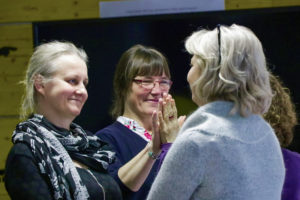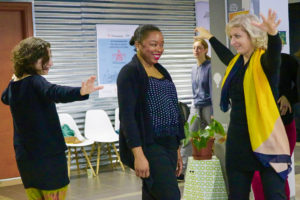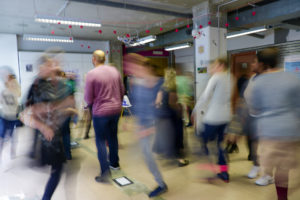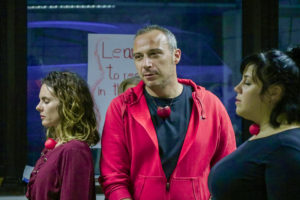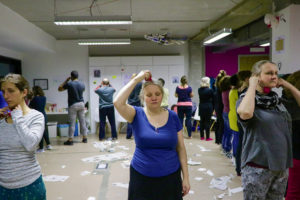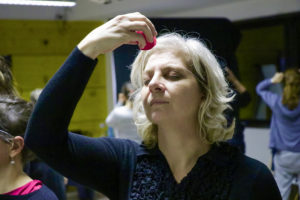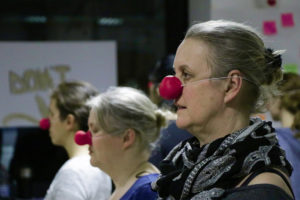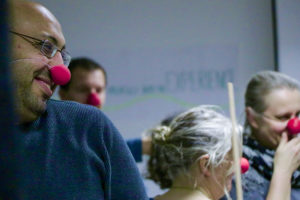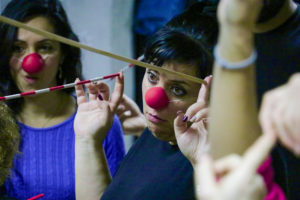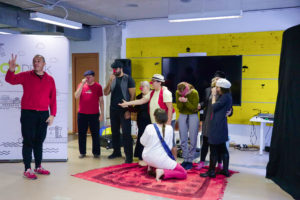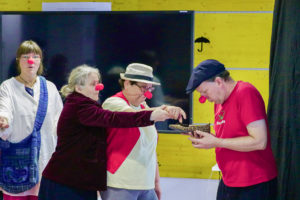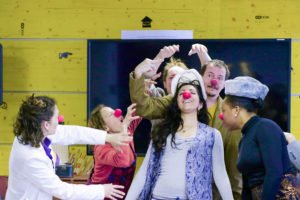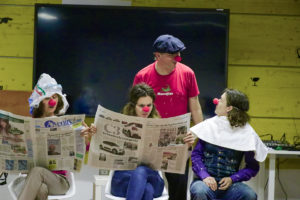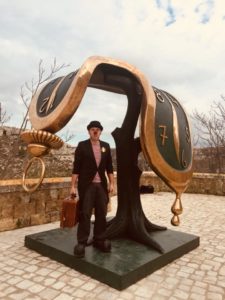More Than Words – November 2018
Training in Potenza
The Clown is radical. In a space of violence and despair, the Clown makes the outrageous gesture of spontaneous joy. In the space of pain, suspicion and mistrust, the Clown offers vulnerability and empathy, the healing contact of the compassionate, unbroken gaze.
In 2002, a group of Clowns, led by Patch Adams, went into Kabul to confront the violence unleashed across Afghanistan by George W. Bush and his allies. The film of their journey is astonishing: it is also deeply upsetting. In one sequence, a young child is treated for the most horrifying skin injuries. Among the doctors, offering presence, openness and care, there is a figure in a red nose, holding a balloon.
Earlier this year, as part of THE PROMISED LAND project, we spent a morning with the remarkable organisation Clowns Without Borders, who have been working regularly amongst the refugees across Europe and the Middle East. To Sam Holdsworth, who runs the UK branch, the presence of the Clown at the moment of arrival is of huge importance in establishing the potential for welcome and moving forward. As somebody emerges from the sea, there should not only be food, warmth and medical care: there should also be a very simple, very basic, acknowledgment of common humanity. Even a joke. How silly, how apparently insignificant. How serious, how profound.
In late November, Lucy, Sinead Emery and I went to Potenza in Southern Italy to work with the wonderful Clown Raffaele Messina as part of the MORE THAN WORDS Erasmus + project. This project looks at how the arts and cultural sectors can engage communities who have little or no knowledge of the local language. I had expected the week might concentrate on the Clown as a workshop technique, looking at the training methodology as a means to communication without language. Instead, Raffaele chose something far more basic – how the Clown can be the face of welcome. How the Clown can offer a sense of something more important than the labours of language learning or the morass of immigration bureaucracy. How the Clown can be the bridge between people.
As a result, the week felt almost Grotowski-like in its concentration on the self. We worked on openness and eye contact, on truly seeing inside the other. We worked on our animal nature, our instinctiveness, the weight or lightness of our bodies in space. We worked on emotion, and on how to concentrate that emotion into the tiny mask of the red nose. I had worked a lot with mask before, and knew its potential to drive one personality from the body and allow another, more elemental being to take possession. I had observed how the great clowns, like Chaplin, were essentially mask actors. What I had not been prepared for was the totally transformative power of the red nose – the way in which a tiny piece of leather or plastic can open up a buried self: childlike, hilarious, innocent and raw. Unleashed in the streets of Materra, the Clowns reached out to locals and to tourists, provoking laughter, tenderness and song. People responded because they felt no threat. Only joy. The radical act of joy.
(http://bordercrossingsblog.blogspot.com/2018/)
In accordance with the aim of the project, this training course, named “Clown: when the silence is More Than Words”, explored, through the tools of the clown, possible ways of communication, beyond words, between different communities, overcoming linguistic and communicative difficulties.
The training course was leaded by Raffaele Messina, a trainer who, seduced by the beauty of the world seen through the eyes of a clown, decided ten years ago to take a trip with no particular destination, in order to explore, in a creative form, this world so strange and fascinating, to live the encounter with himself and with each other through the art of clowning and his artistic and human dimension.
We explored this new form of communication, of artistic mediation, this “pedagogy” of the clown as key to re-read and re-elect the spaces of everyday life, out of the ordinary.
Our aim it was also to use clown’s tools as a new form of communication, of artistic and intercultural mediation, as a communicative, educational and therapeutic tool. A new interactive non-verbal communication.
This training methodology is based on the game, because the game is an innate form of communication and learning that is part of us since birth and succeeds in overcoming both generational and cultural barriers. The game allows the subject to enter the reality from ‘another side’, to reach a dimension that does not distance itself from life but allows it to be approached with different languages, schemes, and dynamics.
Overcome the reality, with its superstructures, its defenses, through the fantasy and the creativity to find a new authentic reality, within and outside of ourselves. This is clown!


